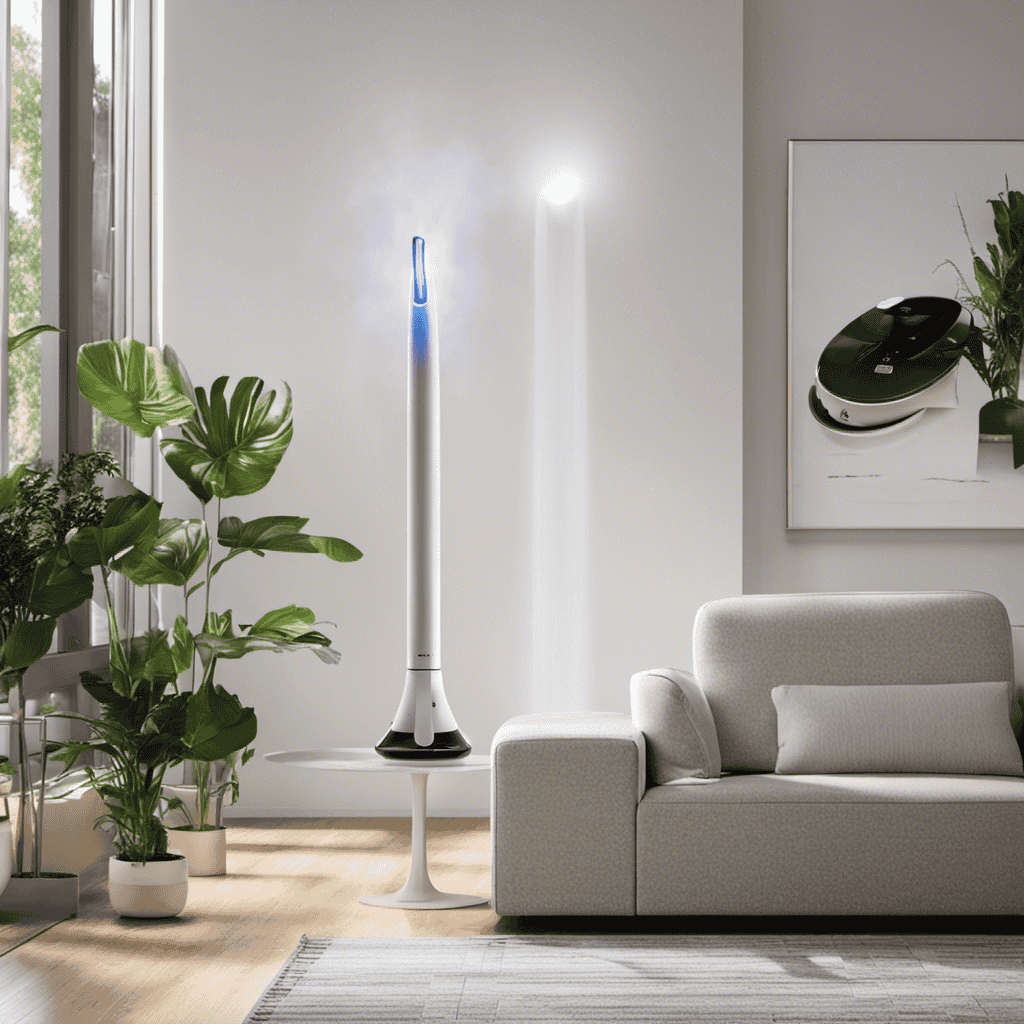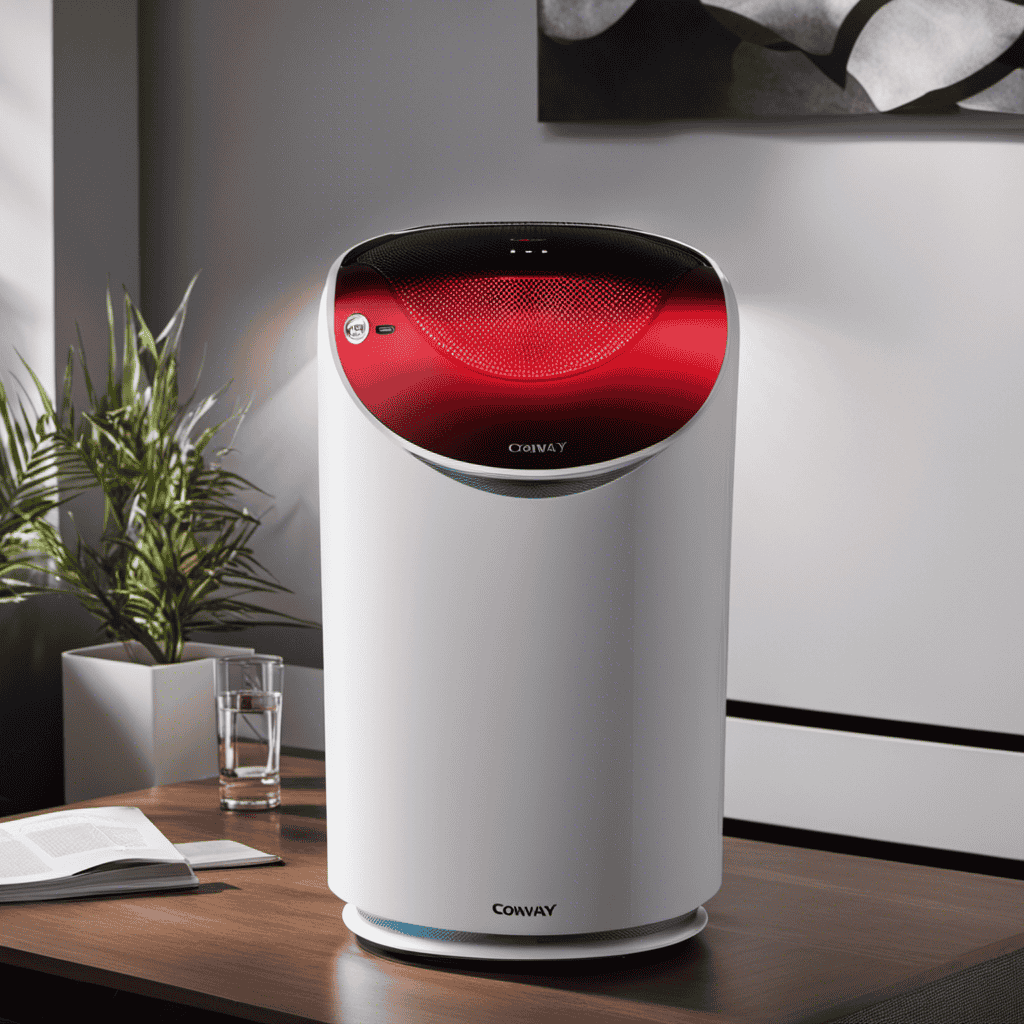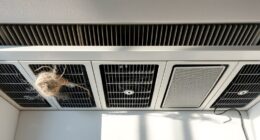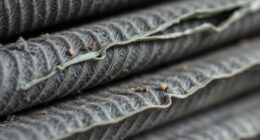As an environmental scientist, I am always researching cutting-edge technologies to enhance indoor air quality. One technology I am particularly interested in is the ionizer air purifier.
You may be curious about how it works, and I’m here to provide you with an in-depth understanding. By utilizing the power of negative ions, these purifiers effectively neutralize odors, protect against bacteria and viruses, and even prevent mold growth.
In this article, I will dive into the intricacies of ionizer air purifiers, shedding light on their mechanisms, benefits, and maintenance tips.
Get ready to breathe in cleaner, healthier air.
Key Takeaways
- Ionizer air purifiers use negative ions to neutralize harmful particles in the air.
- Negative ions attract positively charged particles like dust and pollen, causing them to become heavier and fall to the ground or be captured by the purifier’s collection plates.
- Ionizers can improve indoor air quality by removing particles like dust, pollen, and pet dander, as well as eliminating odors and harmful gases.
- Ionizers may not be as effective in removing larger particles or volatile organic compounds (VOCs) and should be used alongside other air purifying technologies for optimal results.
Understanding the Ionization Process
When ions are released into the air, they attach to harmful particles, neutralizing them and making the air cleaner. Ionizer air purifiers work by generating negative ions, which are electrically charged molecules. These negative ions are released into the air and attract positively charged particles, such as dust, pollen, and pet dander.
Once the ions attach to these particles, they become heavier and fall to the ground, or are captured by the air purifier’s collection plates. This process effectively removes these harmful particles from the air, improving indoor air quality.
However, it is important to note that ionizer air purifiers should be used with caution. Some studies suggest that high levels of negative ions can have negative health effects, such as respiratory issues. Therefore, it is recommended to follow safety precautions and guidelines provided by manufacturers while using ionizer air purifiers.
Transitioning to the next section, let’s explore the benefits of using an ionizer air purifier.
Benefits of Using an Ionizer Air Purifier
One of the benefits of using an ionizer air purifier is that it helps improve the quality of the air you breathe. Ionizers work by emitting negatively charged ions into the air, which attach to and neutralize positively charged particles such as dust, pollen, and pet dander. This process, known as ionization, effectively removes these harmful particles from the air, reducing the risk of allergies and respiratory issues. Additionally, ionizers can also eliminate odors and harmful gases by breaking down their molecular structure. It is important to note that while ionizers can be effective in improving indoor air quality, they do have some limitations. For instance, they may not be as effective in removing larger particles or volatile organic compounds (VOCs). Furthermore, ionizers should be used in conjunction with other air purifying technologies for optimal results. Overall, ionizer air purifiers offer several benefits in improving indoor air quality, making them a valuable addition to any home or office space.
| Pros | Cons |
|---|---|
| Effectively removes small particles | Less effective against larger particles |
| Eliminates odors and harmful gases | May produce trace amounts of ozone |
| Improves indoor air quality | May require regular maintenance |
| Can help reduce allergies and respiratory issues | Limited effectiveness against VOCs |
| Easy to use and maintain | Works best when used with other air purifying technologies |
Key Components of an Ionizer Air Purifier
To understand the key components of an ionizer air purifier, you need to know how it functions. Ionizer air purifiers work by emitting negatively charged ions into the air, which attach to airborne particles and cause them to become heavy and fall to the ground.
The key components of an ionizer air purifier include:
-
Ionization Chamber: This is where the ions are generated using electrical discharge or corona discharge.
-
Collector Plates: These plates attract the charged particles and remove them from the air.
-
Fan: The fan helps to circulate the purified air throughout the room.
-
Control Panel: This allows you to adjust the settings and monitor the performance of the purifier.
-
Filters: Some ionizer air purifiers also include filters to capture larger particles and improve overall air quality.
Understanding ionizer technology is crucial for proper maintenance of these devices. Regular cleaning of the collector plates and filters, as well as monitoring the ion output, are important maintenance tips to ensure optimum performance of ionizer air purifiers.
How Ionizers Generate Negative Ions
The key components of an ionizer air purifier generate negatively charged ions, which are emitted into the air. Negative ions are molecules that have gained an extra electron, resulting in a negative charge. These ions are produced by the ionizer through a process called corona discharge, where high voltage is applied to a series of sharp points or plates.
As the air passes through the ionizer, the electrical discharge causes the molecules in the air to lose or gain electrons, creating negative ions. Once emitted into the air, negative ions attach themselves to airborne particles, such as dust, pollen, and pet dander. This process effectively neutralizes these particles, causing them to become heavier and fall to the ground, thus improving indoor air quality.
Additionally, negative ions have been found to have potential benefits for mental health, as they can enhance mood, reduce stress, and increase overall well-being. However, it is important to note that ionizers may not be suitable for everyone, as some individuals may be sensitive to negative ions and experience adverse effects.
The Role of Negative Ions in Air Purification
Negative ions, generated by ionizer air purifiers, have been shown to offer several benefits in air purification. These ions can help remove pollutants from the air, such as dust, pollen, and pet dander, which are common allergens.
Research has also suggested that negative ions may have a positive impact on allergies, potentially reducing symptoms and improving overall air quality.
Benefits of Negative Ions
One of the benefits of ionizer air purifiers is that they can help improve mood and overall well-being. Negative ions, which are generated by ionizer air purifiers, have been found to have a positive impact on mental health. These ions help to increase the production of serotonin, a neurotransmitter that is known to elevate mood and promote feelings of happiness.
Additionally, negative ions have been shown to improve sleep quality by reducing anxiety and stress levels. This can lead to a more restful and rejuvenating sleep experience. Other benefits of negative ions include increased energy levels, enhanced cognitive function, boosted immune system, improved respiratory health, and reduced symptoms of depression and seasonal affective disorder.
Negative ions have a profound impact on our well-being, and incorporating an ionizer air purifier into your living space can provide these benefits.
Now, let’s explore the connection between negative ions and allergies.
Negative Ions and Allergies
Using an ionizer air purifier can help alleviate allergy symptoms by reducing airborne allergens. Negative ions, which are produced by ionizer air purifiers, have been shown to have a positive impact on mental health and sleep quality.
Negative ions are molecules that have gained an extra electron, giving them a negative charge. When released into the air, these negative ions attach themselves to airborne particles, such as pollen, dust, and pet dander. This causes the particles to become heavier and fall to the ground, effectively reducing their concentration in the air.
By reducing the amount of allergens in the air, ionizer air purifiers can help alleviate allergy symptoms. In addition, studies have shown that negative ions can improve mood, decrease stress levels, and enhance sleep quality by promoting the production of serotonin, a neurotransmitter that plays a key role in regulating mood and sleep.
Ionizers Vs. HEPA Filters: Which Is Better
When comparing ionizers and HEPA filters, it is essential to consider their effectiveness, benefits, and limitations.
Ionizers use the principle of ionization to charge particles in the air, causing them to stick to surfaces or be attracted to an oppositely charged plate. While this can reduce airborne particles, it does not necessarily remove them from the air.
On the other hand, HEPA filters are highly effective at capturing particles as small as 0.3 microns, trapping them in the filter and providing cleaner air. Additionally, HEPA filters are known for their ability to remove various contaminants, including allergens, dust, pollen, and even some viruses, making them a popular choice for those concerned about indoor air quality.
Ionizer Vs. HEPA: Comparison
The ionizer is more effective at removing smaller particles than the HEPA filter. When comparing ionizers and HEPA filters, there are a few key factors to consider:
-
Price comparison: Ionizers tend to be more affordable than HEPA filters, making them a cost-effective option for those on a budget.
-
Energy consumption comparison: Ionizers typically consume less energy than HEPA filters, resulting in lower electricity bills and reduced environmental impact.
-
Effectiveness: Ionizers use charged ions to attract and trap particles in the air, while HEPA filters physically capture particles. Both methods have their advantages, but ionizers are particularly effective at removing smaller particles.
-
Maintenance: HEPA filters require regular replacement, while ionizers generally only require occasional cleaning.
-
Potential risks: Some ionizers produce ozone as a byproduct, which can be harmful in high concentrations. HEPA filters do not produce ozone.
Understanding the differences between ionizers and HEPA filters can help you make an informed decision when choosing an air purifier for your needs.
Effectiveness of Ionizers
To determine how effective ionizers are, you can compare their ability to remove smaller particles. Ionizers work by releasing negative ions into the air, which attach to airborne particles and cause them to become heavy and fall to the ground or attach to surfaces. This process, known as ionization, can be effective in reducing the concentration of smaller particles in the air.
In commercial spaces and hospitals, where there is a higher risk of airborne pollutants and pathogens, ionizers can play a crucial role in improving indoor air quality. However, it is important to note that ionizers may not be as effective in removing larger particles or gases. Additionally, some studies have suggested that ionizers may produce ozone as a byproduct, which can be harmful to human health. Therefore, it is essential to consider these factors when deciding whether to use ionizers in these settings.
Moving on to the benefits of HEPA filters…
Benefits of HEPA Filters
If you’re looking for a reliable way to improve indoor air quality, consider using HEPA filters. These filters are highly effective at removing airborne particles, such as dust, pollen, pet dander, and mold spores.
Here are some benefits of using a HEPA air purifier:
- HEPA filters can capture particles as small as 0.3 microns, ensuring clean and fresh air.
- They are particularly beneficial for people with allergies or asthma, as they can reduce symptoms and improve overall respiratory health.
- HEPA filters can also help remove harmful volatile organic compounds (VOCs) and other pollutants from the air.
- Unlike activated carbon filters, HEPA filters do not release any byproducts into the environment.
- HEPA air purifiers are easy to maintain and don’t require frequent filter replacements.
Overall, HEPA filters are a reliable and efficient choice for improving indoor air quality and creating a healthier living environment.
Common Types of Ionizer Air Purifiers
Consider researching different models of ionizer air purifiers to find the one that best suits your needs. Ionizer air purifiers work by emitting negative ions into the air, which attach to airborne particles and cause them to become heavier. These heavier particles then fall to the ground or are easily trapped by filters, resulting in cleaner air. Negative ions have been shown to have potential benefits for mental health, as they can help to reduce stress and improve mood. Additionally, ionizer air purifiers are also beneficial for pet owners, as they can help to eliminate pet dander and odors from the air. However, it is important to note that some ionizer air purifiers may also produce ozone as a byproduct, which can be harmful to human health. When choosing an ionizer air purifier, be sure to consider its ozone emissions and select one that meets safety standards.
| Pros | Cons |
|---|---|
| Removes airborne particles | May produce ozone |
| Can improve mental health | May not be as effective for larger particles |
| Eliminates pet dander and odors | |
| Relatively low maintenance |
How Ionizers Remove Airborne Pollutants
The ionization process in air purifiers involves the release of negatively charged ions into the air. These ions attach to airborne pollutants and cause them to become positively charged.
These charged particles then bond with nearby surfaces or are collected by the purifier’s collection plates or filters.
The benefits of ionizer air purifiers include their ability to remove a wide range of pollutants, including dust, allergens, smoke, and pet dander. They also improve indoor air quality by reducing the presence of these contaminants.
However, while ionizers are effective against common pollutants, their effectiveness may vary depending on factors such as room size and the specific type of pollutant.
Ionization Process Explained
The ionization process in an air purifier involves the emission of negatively charged ions to neutralize airborne pollutants. Understanding ionizer technology and the role of ions in air quality is crucial in comprehending how these devices work.
Here is a technical overview of the ionization process in an air purifier:
- Negatively charged ions are released into the air by the ionizer.
- These ions attach to airborne particles such as dust, pollen, and pet dander.
- The negatively charged particles become attracted to positively charged surfaces, such as walls or furniture.
- This process effectively removes the particles from the air, improving air quality.
- The ionization process also helps neutralize odors by attaching to odor-causing molecules.
Benefits of Ionizers
Understanding the benefits of ionizers can help you make an informed decision about improving your indoor air quality.
Ionizers work by releasing negative ions into the air, which attach to airborne particles and cause them to become heavy and fall to the ground. This process helps to remove pollutants such as dust, pollen, pet dander, and mold spores from the air, improving the overall air quality in your home.
In addition to removing allergens, ionizers can also help to neutralize odors and reduce the presence of harmful bacteria and viruses. However, it is important to note that ionizers do have some limitations. They may not be as effective in removing larger particles or gases.
When used in conjunction with other air purification methods, ionizers can greatly enhance the effectiveness of your indoor air quality system.
Now, let’s explore how ionizers perform against specific pollutants in more detail.
Effectiveness Against Common Pollutants
To determine how well ionizers combat common pollutants, you should consider their effectiveness against specific types of pollutants. When it comes to pet dander, ionizer air purifiers can be quite effective. They work by releasing negatively charged ions into the air, which attach to the positively charged particles, including pet dander. This causes the particles to become heavier and fall to the ground or attach to surfaces, effectively removing them from the air.
The impact of ionizers on indoor air quality can be significant. They can reduce the concentration of pet dander in the air, which can help alleviate allergies and respiratory issues caused by pet allergens.
- Ionizers can improve air quality by reducing pet dander particles.
- They can help create a healthier living environment for those with allergies.
- Ionizers are effective in removing pet dander from the air.
- They can reduce the risk of allergic reactions caused by pet allergens.
- Ionizers can improve overall indoor air quality and create a more comfortable living space.
Ionizers and Allergens: A Winning Combination
With an ionizer air purifier, you can greatly reduce allergens in your home. Ionizers work by emitting negative ions into the air, which attach to airborne particles like pet dander, pollen, and dust. These negatively charged ions cause the allergens to become heavy and fall out of the air, effectively removing them from your living space.
This is especially beneficial for individuals with allergies or asthma, as it can alleviate symptoms and improve respiratory health. Additionally, negative ions have been shown to have positive effects on mental health, promoting relaxation and reducing stress.
However, it’s important to note that ionizers may not be as effective in completely eliminating larger particles or odors. Regular maintenance and cleaning of the device are also necessary to maintain optimal performance.
Ionizer Air Purifiers and Asthma Relief
Using an ionizer air purifier can help alleviate asthma symptoms by reducing allergens in your home. These devices work by using electrically charged ions to remove harmful particles from the air, such as pollen, dust, and pet dander.
Here are some key benefits of using an ionizer air purifier for asthma management:
-
Decreased allergens: Ionizers can effectively reduce the presence of common asthma triggers, providing relief to individuals with respiratory issues.
-
Improved indoor air quality: By removing pollutants, ionizers contribute to cleaner and healthier air in your home.
-
Enhanced respiratory health: With reduced exposure to allergens, asthma symptoms like wheezing, coughing, and shortness of breath may be alleviated.
-
Compact and portable: Ionizer air purifiers are often small and lightweight, making them easy to move from room to room.
-
Cost-effective: Compared to other types of air purifiers, ionizers are generally more affordable, making them accessible to a wider range of individuals seeking asthma relief.
Overall, using an ionizer air purifier can be a valuable addition to your asthma management plan, providing cleaner air and potential relief from symptoms.
The Science Behind Ionizer Air Purification
In order to fully understand how ionizer air purifiers work, it is important to delve into the science behind ionization technology. Ionization is the process by which ions, either positively or negatively charged particles, are generated in the air. These ions attach themselves to airborne particles such as dust, allergens, and pollutants, causing them to become negatively charged. The negatively charged particles then attract to positively charged surfaces, such as walls or furniture, effectively removing them from the air we breathe.
The benefits of ionizer air purifiers are numerous. They can effectively remove airborne particles as small as 0.01 microns, including bacteria and viruses. Additionally, ionizers do not require filters, making them a cost-effective solution for long-term air purification. However, it is important to note that ionizers may produce ozone as a byproduct, which can be harmful in high concentrations.
Understanding the science behind ionization technology allows us to appreciate the benefits of ionizer air purifiers. Now, let’s explore how ionizers neutralize odors and improve indoor air quality.
How Ionizers Neutralize Odors
In discussing the odor elimination process of ionizer air purifiers, it’s important to understand the mechanism of molecular charge neutralization.
When an ionizer releases negatively charged ions into the air, these ions attach themselves to positively charged odor molecules, effectively neutralizing their charges.
This process eliminates the odor molecules from the air, resulting in a fresher and cleaner indoor environment.
Research has shown that ionizer air purifiers can be effective against odors, but it’s essential to consider their limitations and potential risks as well.
Odor Elimination Process
The ionizer air purifier neutralizes odors through a process that involves releasing negatively charged ions. These ions attach themselves to positively charged odor molecules in the air, causing them to become neutralized and fall to the ground or be collected by the purifier’s filter.
This odor elimination process is facilitated by ionizer technology, which generates the necessary ions to target and neutralize odors. Here are five key points about the odor elimination process:
- Negatively charged ions bind with positively charged odor molecules.
- The neutralized odor molecules are either collected by the air purifier’s filter or fall to the ground.
- Ionizer technology is effective at eliminating a wide range of odors, including those caused by pets, cooking, and smoke.
- The molecular charge of the ions allows them to easily bond with odor molecules.
- The process is continuous, ensuring that odors are constantly being neutralized and removed from the air.
Molecular Charge Neutralization
To neutralize odors, simply remember that negatively charged ions bond easily with positively charged odor molecules. This molecular charge analysis is the foundation of ionizer air purification technology.
In an ionizer air purifier, the device releases a stream of negatively charged ions into the air. These ions attach themselves to the positively charged odor molecules, forming clusters that are too heavy to remain airborne. As a result, the odor molecules are effectively removed from the air, leaving behind fresher and cleaner indoor air. This process is known as ionization.
By understanding the principles of molecular charge and utilizing ionizer air purification technology, we can effectively combat odors and improve indoor air quality.
Now, let’s explore the effectiveness of ionizers against different types of odors.
Ionizer Effectiveness Against Odors
In the previous subtopic, we discussed how ionizer air purifiers work by neutralizing molecular charges in the air. Now, let’s delve into the effectiveness of ionizer air purifiers against odors, particularly pet odors.
-
Ionizer Air Purifier vs. Activated Carbon Filters: Ionizer air purifiers use charged ions to remove airborne particles, including odors, whereas activated carbon filters rely on adsorption to trap and remove odorous molecules.
-
Ionizer Air Purifier and Pet Odors: Ionizer air purifiers can be effective in reducing pet odors by releasing negatively charged ions that attach to positively charged odor molecules, neutralizing them and making them less noticeable.
-
Mechanism of Odor Reduction: Ionizers work by producing negative ions that attach to odor-causing molecules, causing them to settle out of the air or become too heavy to remain airborne.
-
Benefits: Ionizer air purifiers offer continuous odor reduction, do not require filter replacements, and can cover large areas.
-
Limitations and Risks: Ionizers may produce ozone as a byproduct, which can be harmful to human health if present in high concentrations. Additionally, they may not be as effective in completely eliminating strong and persistent odors.
Ionizer Air Purifiers and Bacterial/Viral Protection
Ionizer air purifiers can help protect against bacteria and viruses. These devices work by emitting negative ions into the air, which attach to positively charged particles such as bacteria and viruses. The ionized particles then become too heavy to remain in the air and are subsequently pulled down to surfaces or trapped by the air purifier’s filters.
This mechanism effectively reduces the concentration of airborne bacteria and viruses, providing a cleaner and healthier indoor environment. However, it is important to note that while ionizers can be effective in reducing bacterial and viral contamination, they should not be relied upon as the sole method of protection. Proper hygiene practices, such as regular handwashing and surface cleaning, are still essential.
Additionally, it is recommended to choose an ionizer air purifier that is certified by reputable organizations to ensure its effectiveness.
In the next section, we will explore how ionizers can also help prevent mold growth.
Ionizers and Mold Prevention: How It Works
You can effectively prevent mold growth by using ionizers in your indoor space. Ionizers work by emitting negative ions into the air, which attach to mold spores and make them too heavy to remain airborne. Here are some key points to consider:
- Ionizers help control pet dander, a common allergen that can contribute to mold growth.
- These devices improve indoor air quality by reducing the concentration of mold spores in the air.
- Ionizers work alongside other air purifying techniques, such as filtration, to provide comprehensive mold prevention.
- They are particularly effective in enclosed spaces with poor ventilation, where mold growth is more likely.
- However, it’s important to note that ionizers alone may not completely eliminate mold, as they do not address the underlying moisture issue.
Understanding how ionizers work in mold prevention can help you make informed decisions about improving your indoor air quality.
Now, let’s explore some maintenance tips for ionizer air purifiers.
Maintenance Tips for Ionizer Air Purifiers
To keep your ionizer air purifier running efficiently, it’s important to regularly clean the device and replace the filters as recommended. Proper maintenance ensures that the purifier continues to effectively remove pollutants from the air, providing you with clean and fresh indoor air.
Cleaning the ionizer filters is a crucial part of air purifier maintenance. Over time, the filters can become clogged with dust, pollen, and other particles, reducing their efficiency. Regularly cleaning or replacing the filters ensures optimal performance and prolongs the lifespan of the purifier.
Here is a table summarizing the recommended maintenance schedule for ionizer air purifiers:
| Maintenance Task | Frequency |
|---|---|
| Clean filters | Every month |
| Replace filters | Every 6-12 months |
| Wipe down device | Every 3 months |
Frequently Asked Questions
Are Ionizer Air Purifiers Safe to Use?
Yes, ionizer air purifiers are safe to use. They employ air purifier technology that releases negative ions, which attach to pollutants and allergens, making them heavier and causing them to fall out of the air. This improves indoor air quality and offers health benefits.
Can Ionizer Air Purifiers Remove Pet Dander and Pet Hair?
Ionizer air purifiers can effectively remove pet dander and hair, making them beneficial for pet allergies. They work by releasing negative ions that attach to airborne particles, causing them to become heavy and fall to the ground or be trapped in a filter.
How Long Do the Negative Ions Generated by Ionizers Last in the Air?
The duration of negative ions in the air generated by ionizer air purifiers varies, but studies have shown that they can last for several hours. These negative ions are effective in reducing airborne pollutants and improving indoor air quality.
Can Ionizer Air Purifiers Help With Cigarette Smoke Odor?
Yes, ionizer air purifiers can help with cigarette smoke odor. When choosing an ionizer air purifier, look for one specifically designed to remove smoke particles. They use negative ions to neutralize and eliminate smoke odors from the air.
Do Ionizer Air Purifiers Produce Ozone?
Ionizer air purifiers have numerous benefits, but it’s important to address the concern of ozone production. While some ionizers may produce low levels of ozone, it’s crucial to choose a model that meets safety standards to ensure effectiveness and minimize risks.
Are Ionizing Air Purifiers as Effective as Ionizer Air Purifiers?
Ionizing air purifier operation is different from traditional ionizer air purifiers. While both effectively remove airborne particles, ionizing air purifiers generate negative ions to neutralize pollutants, while ionizer air purifiers use charged plates to trap particles. Each type has its advantages, but their effectiveness ultimately depends on the specific air purification needs.
Conclusion
In conclusion, ionizer air purifiers are highly effective in improving indoor air quality.
By generating negative ions, these devices can neutralize harmful particles and eliminate odors, providing a cleaner and fresher environment.
They also offer protection against bacteria, viruses, and mold, making them a valuable tool for maintaining a healthy home or workspace.
However, it is important to note that regular maintenance is necessary to ensure optimum performance.
Overall, ionizer air purifiers are a reliable and efficient solution for achieving cleaner and healthier indoor air.










